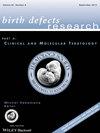Acardiac twin pregnancies part III: Model simulations.
Q Medicine
Birth defects research. Part A, Clinical and molecular teratology
Pub Date : 2016-12-01
DOI:10.1002/bdra.23559
引用次数: 12
Abstract
BACKGROUND Acardiac monochorionic twins lack cardiac function but grow by passive perfusion of the pump twin's deoxygenated arterial blood through placental arterioarterial (AA) and venovenous (VV) anastomoses and by hypoxia-mediated neovascularization. Pump twins therefore must continuously increase their cardiac output which may cause heart failure. Our aims were: to adapt our twin-twin transfusion syndrome model for acardiac twin pregnancies, to simulate pump and acardiac twin development, and to examine the model for early prognostic markers of pump twin survival. METHODS We used an infinite acardiac placental resistance, based on placental dye injection studies and simulations, suggesting the AA-Acardiac-VV series resistance determines the pump twin's excess cardiac output. Pump and acardiac development were expressed by the pump's excess cardiac output versus its normal value, represented by pump/acardiac umbilical venous diameter (UVD) ratios. RESULTS UVD ratios distinguish between AA-VV anastomoses that do and do not cause hydropic pump twins. Pump twins can handle relative larger acardiac perfusion at later than earlier gestation. Both VV and acardiac resistances are significantly smaller than the AA resistance, based on respectively clinical data and acardiac blood volumetric growth. CONCLUSION Our simulations support clinical results which show that UVD ratios aid in the prediction of pump twin risk. The AA anastomosis controls the future of both the pump and the acardiac. Correlation between acardiac size and pump twin risk is secondary to the AA size but remains clinically usable. These factors may aid in the development of methods for pump twin prognosis and the promotion of selective clinical interventions.Birth Defects Research (Part A), 2016.© 2016 Wiley Periodicals, Inc. Birth Defects Research (Part A) 106:1008-1015, 2016. © 2016 Wiley Periodicals, Inc.心脏双胎妊娠第三部分:模型模拟。
心脏单绒毛膜双胞胎缺乏心脏功能,但通过胎盘动动脉(AA)和静脉静脉(VV)吻合口被动灌注泵双胞胎的缺氧动脉血和缺氧介导的新生血管来生长。因此,泵双胞胎必须不断增加心输出量,这可能导致心力衰竭。我们的目的是:将我们的双胎输血综合征模型应用于双心胎妊娠,模拟双心泵和双心双胞胎的发育,并检验该模型对双心泵生存的早期预后标志物。方法:基于胎盘染料注射研究和模拟,我们使用了无限心脏胎盘阻力,提示AA-Acardiac-VV系列阻力决定了泵双胞胎的过量心输出量。泵和心脏的发育由泵的过量心输出量与正常值表示,用泵/心脏脐静脉直径(UVD)比值表示。结果AA-VV吻合术可区分是否会引起液压泵双生。泵双胞胎在妊娠后期比妊娠早期可以处理相对较大的心脏灌注。根据临床数据和心脏血容量增长,VV和心脏阻力均明显小于AA阻力。结论我们的模拟结果支持临床结果,表明UVD比值有助于预测泵双生风险。AA吻合控制着泵和心脏的未来。心脏大小与双泵风险的相关性次于AA大小,但在临床上仍然可用。这些因素可能有助于发展泵双生子预后的方法和促进选择性临床干预。出生缺陷研究(上),2016。©2016 Wiley期刊公司出生缺陷研究(A辑)106:1008-1015,2016。©2016 Wiley期刊公司
本文章由计算机程序翻译,如有差异,请以英文原文为准。
求助全文
约1分钟内获得全文
求助全文
来源期刊

Birth defects research. Part A, Clinical and molecular teratology
医药科学, 胎儿发育与产前诊断, 生殖系统/围生医学/新生儿
CiteScore
1.86
自引率
0.00%
发文量
0
审稿时长
3 months
 求助内容:
求助内容: 应助结果提醒方式:
应助结果提醒方式:


